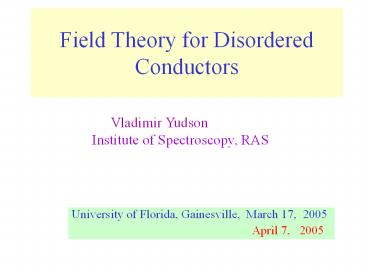Field Theory for Disordered Conductors - PowerPoint PPT Presentation
Title:
Field Theory for Disordered Conductors
Description:
Institute of Spectroscopy, RAS. Electrons in a random potential ... The formalism opens a way to study the complete statistics of fluctuations in ... – PowerPoint PPT presentation
Number of Views:78
Avg rating:3.0/5.0
Title: Field Theory for Disordered Conductors
1
Field Theory for Disordered Conductors
Vladimir Yudson Institute of Spectroscopy,
RAS
- University of Florida, Gainesville, March 17,
2005 -
April 7, 2005
2
Electrons in a random potential
E - H0 U(r) id/2G R(A) (r r) d( r r )
Physical quantities Global DOS ?(E) L?d ?m
d( E Em) i/(2pLd )TrGR(E) -
GA(E) Conductance g gxx 1/(2
L2)TrvxGR -GAvxGR -GA (E EF )
3
Gang of 4 Scaling hypothesis Gorkov, Larkin,
Khmelnitskii (renormalizability) Wegner
(bosonic) nonlinear s-model
no interaction
2 ? d ? 4
2005
2000
1990
Kravtsov Lerner Kravtsov, Lerner, Yudson
(anomalies in the extended s-model (for ltgn gt
)) Altshuler, Kravtsov, Lerner log-normal tails
of distribution functions P(g), P(?), P(t?)
4
Content
- Averaged quantities and nonlinear s-model
- Extended s-model, averaged moments, and
log-normal tails of P(g), P(?), and P(t?) - Secondary saddle-point approach and log-normal
tails of P(t?) - Hypothetical relationship between P(?) and P(t?)
- Field theory for P(?)
5
Averaged quantities - diagrammatics
G0-1(E) - U id/2G R(A) (r r) d( r r )
Expansion in 1/kFl ltlt 1
and ??, Ect (l/L)2 ltlt 1
6
Singular diagrams
Diffuson
q p p
q p p
Cooperon
7
Field theory and nonlinear s-model
Basic object Greens function
Primary representation
Primary variable local field ?(r)
8
Averaging over disorder
ltU(r)U(r') ? ?(r - r')
1/? 2???
Hubbard-Stratonovich decoupling
Primary saddle-point Q2 I Q V ?z V-1
9
Moments ltgngt, lt?ngt (modifications ? ? ?i Q ?
Qij i,j 1, , n )
Hydrodynamic expansion ( ??, l/L ltlt 1 )
Str ln ?(??d D/4) Str (?Q)2 2i?/D ?Q
? usual s-model
c1l2 (?Q)4 c2l2 (?2 Q)2 c3? ?2/D (?Q)2
? extended
Perturbation theory Parametrization Q (1
iP)?z (1 iP)-1 P?z ?z P Q ?z
(1 2iP 2P2 2iP3 2P4 . . . )
Str ln ? ??d StrD(?P)2 i?P2 P4
10
RG transformation of the usual nonlinear sigma
model
- Separation of fast and slow degrees of
freedom
Q2 I Q V ?z V-1 ? Vslow Vfast ?z
Vfast-1 Vslow-1
11
One-parameter scaling hypothesis
12
Moments ltgngt, lt?ngt (modifications ? ? ?i Q ?
Qij i,j 1, , n )
Hydrodynamic expansion ( ??, l/L ltlt 1 )
Str ln ?(??d D/4) Str (?Q)2 2?/D ?Q
? usual s-model
c1l2 (?Q)4 c2l2 (?2 Q)2 c3? ?2/D (?Q)2
? extended
Anomalies (KL, KLY)
RG transformation of additional scalar vertices
13
RG transformation of additional vector vertices
Conformal structure ?Q ?xQ i?yQ ?
14
AKL Growth of cumulant moments lt(?g/g)n gtc
lt(??/?)n gtc g1-n (l/L)2(n1) exp u (n2
n),
n gt n0 u-1
ln (L/l) g
g22n , n lt n0
Log-normal asymptotics of distribution functions
P(x) exp (1/4u) ln2(x/??) , x ??/? gt
0 OR ?g/g lt 0
? 1/(? Ld) - mean level spacing
15
AKL Long-time current relaxation - distribution
of relaxation times
Anomalous contribution to ?(?) ? log-normal
asymptotics of ?(t)
?(t) exp (1/4u) ln2(t/?g)
? exp t/t? P(t?) dt?
Distribution of relaxation times
P(t? )
exp (1/4u) ln2(t? /?)
Relationship between P(? ) and P(t? )
(Kravtsov Mirlin)
Energy width of a quasi-localized state ?E
1/ t?
P(? ) ? P(t? )
Anomalous contribution to DOS ?? 1/?E t?
16
Muzykantskii Khmelnitskii Secondary
saddle-point approach
ltg(t)gt g0exp( t/?) ? d?/2? exp(-i?t) ? DQ
exp (- SQ) , SQ ??/4 ? dr Str D(?Q)2
2i??Q
Parametrization Q VHV-1 H H(?, ?F)
Saddle-point equation for ?(r) ?2?
?2sinh ? 0 ?2 i?/D
Boundary conditions ?leads 0
?n?insulator 0
Integration over ? ? self-consistency equation
? dr/Ld cosh ? 1 t?/?
17
d2 , disk geometry (Mirlin)
- ? (r) - singular at r ? 0
- (breakdown of the diffusion approximation!)
Requirement ??(r) lt 1/l
Cutoff r lt r ??(r) 0
r C l
Solution
(? 1, 2, 4)
g(t) (t?) 2??g , 1 ltlt t? ltlt (R/l)2
g(t) exp ??g ln2(t/?g)/4ln(R/l) , t? gtgt
(R/l)2
Coincides with the RG result of AKL
18
However, no alternative way for P(?) and P(g)
(no field theory for P(?) and P(g) !)
Wanted Field theory for
distribution function Requirements
disorder averaging slow functional
description RG analysis
non-perturbative solutions
19
Standard routine Primary field-theoretical
representation fields Averaging
over disorder Hubbard-Stratonovich decoupling,
new field Q(r) Primary saddle point
approximation ( Q2 I ) Slow Q-functional
(nonlinear s-model ) Non-perturbative solutions
(secondary saddle point) Is all this possible
for distribution functions?
20
Results
Effective field theory for the characteristic
function
Free action
Source action
k diag1, -1
Q(r) Qr1,r2(r) Q2(r) I
C 1 4?2?2-1
21
Derivation
Primary representation
- bi-local primary superfields
K diag?, I
Explicitly
?z i?y
22
Integrating over
Finally
Averaging over disorder and H-S decoupling of
by a matrix field
As a result
23
Primary saddle-point approximation
Saddle-point
Slow functional
24
Correspondence with the perturbation theory
ln P(s) ? s (s?/2?)2 ?q?0 (Dq2)?2
lt??/?gt 0 lt (??/?)2 gtc ?2/(2?2) ?q?0
(Dq2)?2
Non-trivial accidental cancellation of two-loop
contributions to lt (??/?)3 gtc
25
Beyond the perturbation theory
Secondary saddle-point equation
26
Wigner representation
In the considered hydrodynamical approximation
(non-extended s-model)
27
Long-tail asymptotics of
Inverse transformation
Parametrization of the bosonic sector
28
Boson action
Self-consistency equation
29
Saddle-point equation for boson action
MK equation, for comparison
?2? (r) ?2sinh ?(r) 0 ?2 i?/D
Formal solution
30
Saddle-point action leads to
31
Conclusions
A working field-theoretical representation has
been developed for DOS distribution functions
The basic element integration over bi-local
primary superfields Slow functional (in the
spirit of a non-extended nonlinear s-model) has
been derived Non-perturbative secondary
saddle-point approach has led to a log-normal
asymptotics of distribution functions The
formalism opens a way to study the complete
statistics of fluctuations in disordered
conductors































